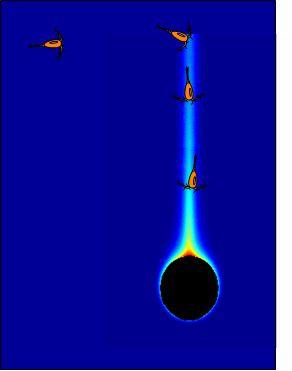|
Marine snow are millimetre to centimetre sized aggregations of smaller particles, mainly phytoplankton and detritus. They occur ubiquitously in the ocean, at times in very high concentrations, and they are supposed to be the main vehicles for vertical material transport in the ocean. They are porous and fragile, and they easily disintegrate to primary particles when sampled by traditional means. They can be collected and visualised, e.g., in the Sea Core Sampler (Kiørboe 2007).
|
|
Formation of marine snow
|
Physical coagulation
Marine snow may form by physical coagulation: Turbulence or other processes bring particles to collide. If the particles are "sticky", they may stick together upon collision, and eventually form large aggregates (animation by A. Visser).
|
|
|
Discarded mucus feeding webs
Marine snow may also form from discarded mucus feeding webs, e.g., the mucus houses that larvaceans produce. The video shows a feeding larvacean (Oikopleura sp.) and the illumination emphasises the mucus house with its outer and inner filters. The animal itself consists mainly of a small "head" and a long, beating tail, that produces the water current. Large particles are retained on the outer filter, whereas smaller particles are captured by the inner filter and eaten. Because the outer filter clogs eventually, houses are renewed every few hours.
|
|
|
Collaps of discarded mucus feeding webs
Initially, the discarded house can be recognised, but after a while it collapses into a rather dense structure with high sinking velocity. The fecal pellets stemming from the larvacean reveals the origin of the marine snow aggregate.
|
|
Fate of aggregates of marine snow
Aggregates typically have higher sinking velocities than their component particles and, hence, a significant fraction of aggregated material sink out of the surface layer to the ocean interior or to the seafloor. However, a significant fraction is also remineralised in the upper ocean, both due to the activity of micro-organisms, and because zooplankton eat aggregates.
|
Zooplankters feed on sinking particles
Many zooplankters are "flux-feeders". They sit at depth and expose a large capture area perpendicular to the vertical in order to intercept sinking particles. This copepod (Haloptilus sp.) in the video is one example (stillphoto by Russ Hopcroft).
|
|
|
Zooplankters colonize sinking aggregates
Other zooplankters directly colonize sinking aggregates, as here the copepod Microsetella norvegica (movie by M. Koski).
|
|
|
How do copepods find aggregates?
How do copepods find aggregates? This way? Sinking particles leak dissolved organic material which paints a chemical trail in its wake. Can zooplankters use this to find the particle?
|

|
|
Testing the hypothesis
A porous sphere that leaks organic solutes is placed in an upward flow, creating a narrow chemical trail downstream (above the sphere). The particle is observed with two cameras from 2 directions (right angle), and only those zooplankters that are directly above the sphere in both views are in the chemical trail. Run the video and draw you own conclusion (Kiørboe 2001).
|
|
Back to list of research areas